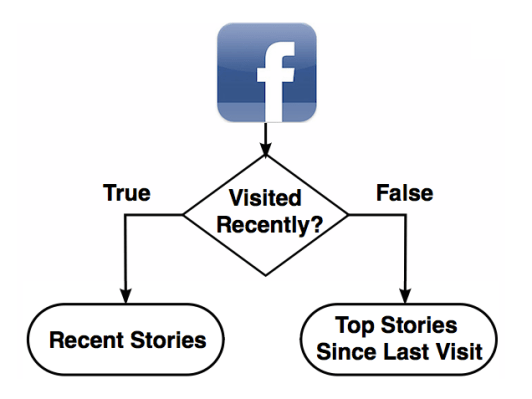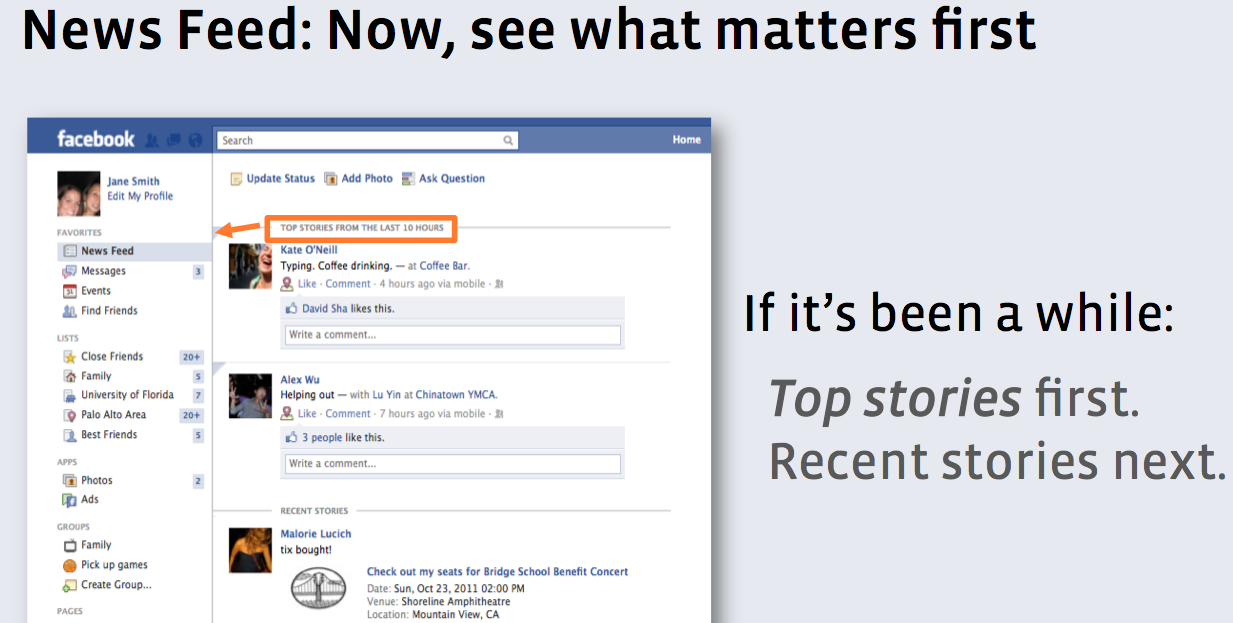When someone you haven’t seen in a while asks you “What’s up?” or “How are you?”, you probably give them a high-level summary of the major life events from the months since you last spoke. When you speak to someone you see frequently, you probably respond to the same questions with close-up, specific descriptions of your activities over past few days. Humans are aware of when and what we last communicated with someone, and we dynamically alter what information we provide to avoid repetition.
While most of the discussion about Facebook’s latest changes has centered around the real-time Ticker, the switch to a news feed that displays different content depending on when you last visited will also profoundly change how we use the social network. Eventually, I think the “return visit-aware” concept will also change how we consume content across the web.
Before the switch, Facebook was struggling with repetitive content and a user base that engages with the site in very different ways. Frequent visitors — those returning multiple times a day — would often see the same stories first on the default Top News feed. Some wouldn’t go to the trouble, while others didn’t even realize they could switch to the Most Recent tab to see what had just been published. This led them to feel that Facebook was stale and caused them to quickly navigate away.
Meanwhile, those who visited once or twice a week would only see the the most Liked, commented on, and clicked stories of the last few hours or day, leading them to miss highly relevant stories that happened a few days ago. This made it seem like nothing really interesting was happening on Facebook and that there was no reason to stop by more frequently. These interactions didn’t mimic the tradition of human communication. With the single-tabbed return visit-aware news feed, Facebook has solved all these problems by aligning its interface with natural human habits.
The Top News and Most Recent tabs have been combined into a single one, shifting the initial burden of choice from the user to Facebook. This works because a human typically doesn’t ask someone “Tell me what’s happened to you in the last [78 hours or 35 minutes]?” The respondent simply knows when they last spoke and tailors their transmission appropriately.
When you vist, the news feed surfaces the most relevant stories from between then and your last visit. If it’s been a week since your last visit, it shows only the biggest stories from that timespan, making sure you don’t miss anything important. This mimics how friends who’ve been out of touch for months communicate when reunited.
If you visited a few hours ago, it will show you the most relevant stories from those hours, but also a “25 more recent stories” link at the top. Similarly, if you’ve spent a day apart from someone, you might tell them the most significant news of the day, but also about your current mood.
If you’ve visited the Facebook home page multiple times that day, it shows you the latest updates so there’s something fresh to see. Similarly, after working together all day and discussing bigger news, but then taking a lunch break apart, two coworkers might discuss in person who they had lunch with. Otherwise, this information might seem inconsequential like the minutiae the news feed shows if you constantly check it. But since all other information has already been discussed, the very recent becomes relevant.
By marking and unmarking stories as “highlighted” using the blue corners in the interface, you can teach Facebook’s EdgeRank news feed ordering algorithm your preferences. This mirrors how you can interrupt a friend’s boring story and ask about something else, or ask follow up questions about a topic such that they bring up that topic more in the future.
The end result is a news feed that usually shows interesting content. This inspires longer session times; more return visits; and more Likes, comments, and shares on news feed stories that trigger notifications or create content that pulls in other users.
Return Visit-Aware Content Streams For The Rest Of The Web
Sites and services around the web are seeking these same benefits, and therefore I believe they’ll look to develop their own versions of consumption-sensitive content streams. Right now, most news sites try to approximate this by featuring the most important content of the last day or so, and rearranging and demoting top stories as they grow older. Techmeme is probably the best example of this, but still they all essentially operate on the premise that you visit every 12 to 18 hours. Vist less frequently than that, and a must-read piece of news may have slipped down and off the home page.
Last week I reviewed an iOS app called the Riversip Tech Reader. It tackles the problem by letting users toggle between viewing the latest news, top news of the day, or the biggest stories of the week. This is probably the easiest solution and it doesn’t depend on tracking a user’s previous actions. It also works for streams which don’t require click-throughs to expand individual pieces of content. However, it does place the burden of choice on the user. Twitter or some Twitter app could try this, surfacing the stories with the most retweets from a given time period.
An approach for when users must take an action such as clicking through to consume content is to remove, demote, or set aside content a user has already viewed. Imagine if the CNN home page replaced tiles or headlines of any story you’ve already read with something you haven’t. This could possibly be done through cookies or another tracking scheme, but it would presumably be more accurate if a user was logged in.
Sites services, and apps with login functionality or another way to tie actions to identity should be considering how they can make their content displays truly sensitive to when a user last visited without explicit input. Using its login and other social plugins, Facebook may even seek to power this shift of other sites. In either case, the content relevancy arms race is on. The same way newspapers look hopelessly static next to Techmeme will be the way the sites of today will look next to the personalized, return visit-aware sites of tomorrow.

